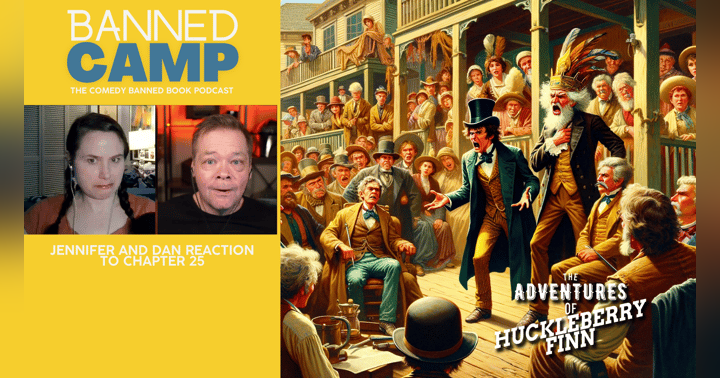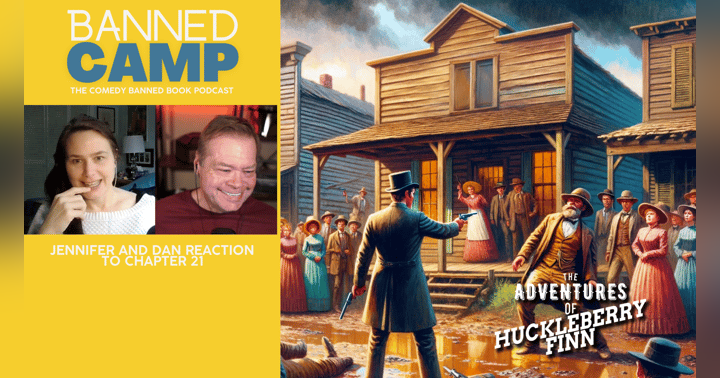Huckleberry Finn Chapter 18: Banned Camp's Deep Dive into Twain's Controversial Classic

Introduction: Unveiling the Layers of Chapter 18 in "The Adventures of Huckleberry Finn"
Welcome to a deeper journey into the world of banned literature, where every page turned is a step into the unknown and every chapter read is a new discovery. In a recent episode, Jennifer and Dan discussed the first part of Chapter 18 of Mark Twain's "The Adventures of Huckleberry Finn" thoroughly in their EPISODE. This chapter, split into two parts for a more insightful exploration, offers a unique blend of Twain's narrative mastery and the poignant themes that resonate even in today's society.
In "Banned Camp," we delve into the controversial, the misunderstood, and the outright banned books, examining why these stories have rattled cages and stirred debates. Our target audience isn't just anyone interested in banned books or literature; it's for those who seek thought-provoking discussions sprinkled with a touch of humor. In this article, we're not just revisiting a chapter of a classic novel; we're embarking on a journey to uncover the layers beneath the surface of Twain's words.
What makes Chapter 18, or rather, the first half of it, so intriguing? Is it the vivid characters, the intricate social commentary, or something deeper, hidden within Twain's clever prose? As we dissect this chapter, we're not only engaging with the text but also with the historical and cultural contexts that make "The Adventures of Huckleberry Finn" a perennial subject of debate and discussion. Let's dive into the first part of Chapter 18, unravel its intricacies, and discover what makes it a centerpiece in the conversation about banned literature.
What is in the First Half of Chapter 18 of "The Adventures of Huckleberry Finn"?
If you're catching up or just joining the "Banned Camp" journey, you can explore all episodes about "The Adventures of Huckleberry Finn" here. Now, let’s dive into what happens in the first half of Chapter 18 of this contentious yet captivating novel.
In this segment, Mark Twain paints a detailed portrait of two feuding families – the Grangerfords and the Shepherdsons. Through Huck's eyes, we are introduced to the Grangerford family, led by the dignified Colonel Grangerford. His family, including his sons Tom and Bob, younger son Buck (who shares similarities with Huck), and his sweet, beautiful daughters, Miss Charlotte and Miss Sophia, are all part of this complex tapestry. The chapter also briefly mentions the Shepherdson family, setting the stage for a deeper conflict.
The core of this chapter revolves around a longstanding feud between these two families, rooted in a thirty-year-old legal dispute over land. Twain uses this family feud to explore themes of senseless violence and the cyclical nature of revenge. There’s a blend of innocence and impending tragedy as Huck and Buck encounter Harney Shepherdson, leading to an intense and dangerous situation.
Miss Sophia's mysterious note, "Half past two," found in a Testament, adds an element of intrigue and foreshadows events to come, encapsulating Twain's skill in weaving mystery and suspense into the narrative.
This chapter isn't just a recount of events; it's a mirror to the societal norms of the era, wrapped in Twain's signature wit and keen observation. It sets the stage for the critical events that follow, making it a pivotal part of the novel.
Character Development
The Grangerfords and Shepherdsons: Portraits of Feuding Families
In this pivotal chapter, Twain doesn't just introduce us to new characters; he immerses us in their world. The Grangerfords, depicted through Huck's observant eyes, are more than just characters; they represent a facet of society. Colonel Grangerford, the patriarch, is the epitome of southern gentility and honor, yet these traits are juxtaposed with the violent feud he partakes in. His children, mirroring his characteristics, add layers to the family dynamic, showcasing how personal traits are overshadowed by familial legacy.
Huck's Perspective and Growth
Then there's Huck, our ever-evolving protagonist. His interactions with the younger Buck Grangerford offer a fresh lens to view this world. Huck, typically the observer, now becomes a participant in the Grangerfords' saga. This chapter marks a subtle shift in Huck's character – from a passive observer to someone who begins to question the world around him, especially the senselessness of the feud. His growth is nuanced, yet significant, as he navigates through the complexities of this new environment.
Through these characters, Twain masterfully critiques the societal norms of his time. The character development in this chapter isn't just about personal growth; it's a reflection of the societal attitudes that Twain aims to dissect and criticize.
Themes and Symbols
Feud and Conflict: A Mirror to Society
One of the most striking themes in this part of Chapter 18 is the senseless feud between the Grangerfords and Shepherdsons. Twain uses this ongoing conflict as a metaphor for the broader societal issues of his time, particularly the senseless violence and the cyclical nature of revenge. This feud, based on a long-forgotten cause, highlights how deeply ingrained and destructive such conflicts can become, reflecting on the human tendency to perpetuate violence without questioning its origin or purpose.
Symbols and Messages: Understanding Twain's Deeper Meanings
Twain's use of symbols in this chapter adds depth to his storytelling. The mysterious note in Miss Sophia's Testament – "Half past two" – is more than just a plot device; it symbolizes the secrecy and underlying tensions that pervade the narrative. This seemingly innocuous note sets off a chain of events, symbolizing how small actions can have significant, unforeseen consequences. It also serves as a symbol of the undercurrents of intrigue and danger that lie beneath the surface of seemingly genteel southern society.
These themes and symbols in Chapter 18 are crucial to understanding Twain's critique of society. They provide a lens through which we can examine not only the characters and their actions but also the societal norms and attitudes that Twain aims to explore and critique in his novel.
Chapter's Impact on the Overall Story
The first half of Chapter 18 in "The Adventures of Huckleberry Finn" is not just a standalone segment; it plays a crucial role in the tapestry of the novel's broader narrative. This chapter serves as a significant pivot point in the story, marking a transition from Huck's adventures to a more profound exploration of societal themes and human behavior.
The introduction of the Grangerfords and Shepherdsons, with their longstanding feud, provides a stark contrast to Huck's previous experiences. It's here that Twain begins to delve deeper into the themes of entrenched societal conflicts and the absurdity of long-held grudges based on forgotten reasons. This change in setting and tone is pivotal, as it shifts the narrative from mere adventure to a more serious critique of societal norms.
Furthermore, Huck's growing disillusionment and questioning of societal values are accentuated in this chapter. His interactions with the Grangerfords and his observations of their feud contribute significantly to his moral development. This is where Huck begins to see the complexities of the world in a more nuanced light, setting the stage for his further evolution as a character.
In summary, the first half of Chapter 18 is vital in shaping the overall trajectory of "The Adventures of Huckleberry Finn." It introduces key themes and conflicts that are central to the novel's message, and it marks a turning point in Huck's character development, making it a foundational piece in Twain's masterpiece.
Banning Triggers: Themes from This Chapter
The exploration of the first half of Chapter 18 in "The Adventures of Huckleberry Finn" by Jennifer and Dan on "Banned Camp" brings to light various themes that might trigger censorship or banning. Yet, despite recognizing these themes, they conclude that none provide a justifiable reason to ban the book.
One of the prominent themes in this chapter is the depiction of violence and conflict, exemplified by the feud between the Grangerfords and Shepherdsons. This portrayal of senseless violence and its impact on families and communities could be seen as controversial or unsettling. However, Twain uses this as a tool to critique and reflect upon the absurdity and destructiveness of such conflicts, offering a profound commentary on human nature and societal flaws.
Another potential trigger is the nuanced portrayal of societal norms and behaviors of the time, particularly those related to family honor and revenge. These depictions provide a window into the historical context but might be misinterpreted as glorifying or trivializing these aspects of the past.
Despite these themes, Jennifer and Dan conclude that the chapter, and by extension, the book, should not be banned. Twain's work is a critical examination of society, using satire and irony to challenge and provoke thought. Banning the book would not only suppress these important discussions but also overlook the novel's value as a historical and literary piece that encourages critical thinking and reflection on past and present societal issues.
Conclusion
Banned Camp, a comedy podcast where we read banned books and find out why they were banned in the first place. Dive into our banned book podcast to explore more.
Further Reading
For those captivated by "The Adventures of Huckleberry Finn" and its layers of meaning, there is much more to explore. We recommend the following resources for a deeper understanding of the novel and its themes:
“Mark Twain: A Life” by Ron Powers: This biography provides a comprehensive look at Twain’s life, offering insights into the experiences that shaped his writing. Link to Book
“The Annotated Huckleberry Finn” by Mark Twain and Michael Patrick Hearn: An in-depth exploration of the novel with annotations and historical context, this book is perfect for those looking to understand the finer details of Twain’s work. Link to Book
“Was Huck Black? Mark Twain and African-American Voices” by Shelley Fisher Fishkin: This work delves into the influence of African-American speech and culture on Twain’s writing, offering a new perspective on “Huckleberry Finn.” Link to Book
These resources are just the beginning of a journey into the world of Mark Twain and his timeless classic. They provide a richer context and understanding of the themes and controversies surrounding "The Adventures of Huckleberry Finn."










